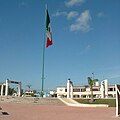On July 1, 1999, President Zedillo officially started the flag program by issuing a decree that was published in the government register Official Journal of the Federation. While the formation of the flag project was one aspect of the decree, the overall aims of the law were to promote the flag, the Coat of Arms and the national anthem to instill a sense of patriotism into the Mexican population. Zedillo also used the timeframe of 1995 until 2000 to promote Mexican culture and history. Finally, this decree allowed the governors of each state to display more conspicuously the national symbols (Símbolos Patrios) throughout their state.
The flag program
The deployment of banderas monumentales was outlined by Zedillo in a two-point program. The first point consisted of selecting the location for the monumental flags, of which the first were:
The first two deployments were in México City, Mexico's capital. The next two were in Tijuana and Ciudad Juárez, along the northern border with the United States. Veracruz is Mexico's main seaport in the Gulf of Mexico. Finally, Iguala was where the flag of the Three Guarantees (Bandera de las Tres Garantías) recognized as Mexico's first flag, was created.
The second point in the program accounted for the creation of a standard size for the flags and the poles they would be raised on. Zedillo's official decree stated that the flag sizes will be 14.3 metres (47 ft) in height by 25 metres (82 ft) in width. The flag size is close to the 4:7 ratio as stated in Article 3 of the Law on the National Coat of Arms, Flag and Anthem (Ley sobre el Escudo, la Bandera y el Himno Nacionales). The flagpoles were to have a height of 50 metres (160 ft).
There have been smaller flags called banderas semi-monumentales installed for schools, smaller communities and other locations where logistics complicate the flying a giant flag. The flags are greatly smaller than its those outlined in the 1999 decree, but have the advantages that are cheaper and easier to take down than the monumental flags. Monumental flags are costly to construct and require a group of nearly twenty people to raise and lower them.















